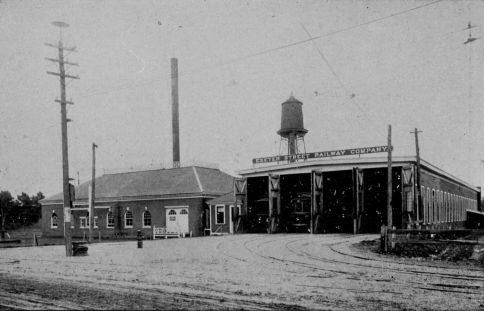
"Our Town" by James W. Tucker
Hampton Union
Thursday, October 4, 1951
PART 2Our town's first electric railway was discussed briefly in this column last week. We told how the first spike was driven in the first rail by Judge Charles M. Lamprey at a point on Winnacunnet Road about opposite Hotel Whittier. We also gave a brief resume of Judge Lamprey's remarks on this auspicious occasion. We knew that the launching of this important project was accompanied by appropriate exercises, but it remained for one of our senior citizens to inform us concerning the extent of the celebration. It seems that the pupils at Hampton Academy were given time off by Principal Jack Sanborn in order that they might witness the laying of the first trolley rail and the Center school was also recessed. And we are told that others who were heard on the program included the promoter, Wallace D. Lovell; C. L. Cotton from Dedham who is described as owning the charter or franchise of the new road and a Mr. Godfrey who, at the time, was one of our town's first citizens.
May 19, 1897 was certainly a red-letter day in Hampton history. And in order to keep the record straight, the senior citizen who told us more about the May 19th celebration that we can put in print, also said that the section of our town sometimes referred to as "Guinea" bore the same appellation long before the Italian laborers, who built the trolley line, were quartered in that locality. In any event, the Exeter Street Railway, begun on May 19, 1897 was finished as far as the Exeter terminal is concerned on July 3, 1897 and the terminal point at Hampton Beach -- a point on ocean boulevard about opposite Highland avenue -- was reached on July 9th of that year.
Carhouse and Power Plant

Rolling Stock and Schedules
During the latter part of the afternoon of July 5, 1897, the first car ran from the carhouse to Court Square in Exeter. In a few days, regular service was inaugurated between that town and Hampton Village. When the line was completed to Hampton Beach on July 9, a half-hourly schedule was immediately placed in effect between the Beach and Exeter. This schedule was continued until late in September when an hourly time-table was put in operation for the fall, winter and spring periods.
Fare and Profits
According to report, the first year of operation proved financially successful for the new electric railway, which, by the way was one of the first in this section of New England. Round trips from Exeter to Hampton numbered 6,625 for a total of 159,000 car miles. The passengers carried during the first year of operation (1897-98) numbered 554,849 and these fares, plus receipts from mail and express with other miscellaneous income, yielded total revenue in the amount of $29,022.97. The operating expenses, including bond interest of $4,875, totaled $24,092.14, leaving a net operating income of $4,930.83.
Interlocking Directorates
Before this promotion group became interested in the Exeter Street Railway, they had organized the Franklin Construction Company for the purpose of building trolley lines. So, it was arranged that this construction company would build and equip the Exeter Street Railway, receiving as payment such capital stock and bonds as the new utility would be authorized to issue, except that the directors of the railway were to receive ten shares of stock. At this same time Lovell organized the Rockingham Electric Company which was chartered on March 19, 1897. This utility was to purchase electricity and power from the Exeter Street Railway which it would in turn resell to residents of Hampton and Exeter, a business which the Railway Company could not legally engage in under its charter. Concerning this deal, the Railroad Commission report said:
Railroad Commission Objects
"Assuming that these bargains and contracts which these men have made with themselves are binding upon the street railway, then the owners of the railway securities, who furnish all the money will be at the mercy of the construction company until the road is completed and of the electric company afterwards.
"We place upon the record our disapproval of the arrangements by which those in control of the corporations have placed themselves in a position in which, if they are so disposed, they can prey upon the property of the railway company after disposing of its securities and we suggest to all concerned a radical modification of the plans and practices of the managers of this enterprise so as to bring them within the law."
But without regard to the adverse opinion of the Railroad Commission of New Hampshire, the Lovell syndicate of electric railway utilities which so greatly contributed to the early development of our town, continued to grow and to prosper. In all probability changes were made in the various corporation set-ups which met with the eventual approval of the Railroad Commission. Next we shall endeavor to trace further the rapid spread hereabout of the Lovell enterprises.
